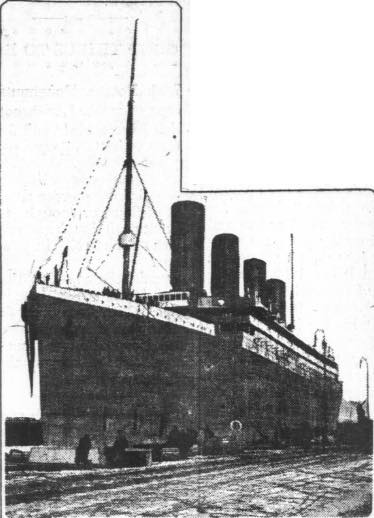
Here is another retelling of the myth of the cursed mummy on the Titanic. Published in 1914, this retelling states that the mummy case was snuck onto the Titanic with false paperwork because the millionaire who bought it did now want to go through the hassle of customs.

The World Famous Hoodoo Mummy A Secret Passenger On The Titanic?
THE notorious haunted mummy case in the British Museum is now credited by the superstitious with having caused an even greater tragedy than any yet recorded in its 3,000 years of tragic history.
This time it is the dreadful Titanic disaster that is associated with the deadly mummy case. According to a story which is being widely circulated here the beautifully painted and gilded mummy case, which is an object of remarkable interest, was secured by an American millionaire from the museum, where it had been placed in the cellar to save the attendants and visitors from the baleful effects of its exhibition in the public rooms! The American shipped it on the Titanic, and the great ship went down in the manner everybody is familiar with.
The story of this latest episode is published by the International Psychic Gazette, a journal extensively ready by those interested in psychic research and various forms of mysticism and alleged supernatural phenomena. Here is its account:
“Every one has heard of the malign Egyptian mummy case which was brought to the British Museum some years ago, and whose presence dealt death and disaster to attendants and others who looked upon it. A story is now being told in well informed circles which is said to have emanated from one of the museum authorities. From this it would appear that several of the museum attendants, convinced that they were in danger of their lives, presented an ultimatum that the coffin lid must be removed from their vicinity or they would resign.
“Their demand was considered by the curators, and , in view of the catalogue of calamities that somehow seemed connected with the mummy case, their demand was considered reasonable. A replica was accordingly made and painted in exact facsimile, and this was exhibited to the public as the real thing, no outsider being any the wiser or the worse. The coffin itself was deposited in an obscure cellar in the vaults of the museum. Then all stories as to the evil influence of the Egyptian coffin ceased.
“The attendants exhibited the replica with calm minds and stolid inscrutability. The public who gazed upon it suffered no ill effects. By and bye, however, an American Egyptologist inspected the coffin and ascertained that it was certainly not genuine. It was a faithful copy, but his expert eye discovered it to be a fraud! To drop on the British Museum exhibiting a fake was an event of first class importance, and an exposure that would have brought worldwide ridicule upon the venerable British repository of antiquarian art and treasure seemed imminent.
“The curators, there fore, took the American visitor into their confidence and explained what had been done. Moreover, they took him to the cellar and showed him the original coffin, and he declared that he was satisfied.
“‘But look here,’ he said. ‘I guess this fine mummy case is not a bit of good to you in your cellars. I want that coffin for America! I’ll make you a bid for it!’
“He did and it was sold to him on his own terms. It was carefully packed, so that no one could guess what its covering case contained; and arrangements were made so that no hitch would be caused by Custom House examinations. And so the coffin was dispatched to America — on board the Titanic! It now rests miles deep in the Atlantic. The question being discussed is whether the coffin’s reputed diabolic power hurled the leviathan to its doom.”
However baseless, irrational and credulous their attitude may appear, many persons undoubtedly believe that the mummy case really had a mysterious connection with this and other tragedies. The fact that so many persons have been affected by terror of this inanimate object is in itself a subject of serious interest.
The mummy case is that of the Princess Hetare, daughter of the Pharaoh Amen Hotep III of the eighteenth dynasty, one of the greatest kings of ancient Egypt. The Princess was a priestess of the Temple of Amen Ra, and lived about 3,000 years ago.
The mummy itself was separated from the case many years ago and lost. This is an important part of the tragic history of the relic. A mummy case is really more interesting than the mummy itself. When the case is of fine quality it bears a striking likeness of the deceased, is richly decorated and is in every way an object of high art. The case in question is a splendid specimen. The mummy itself is but an unsightly bundle of withered flesh, bones, and dungy wrappings.
The Princess Hetare deserted the Temple of Amen Ra in order to aid her half brother, who was fighting for the throne. The curse of the god has rested upon her ever since. Thus began the story which was published when her evil influence first attracted notice. History tells us that she was murdered by a devotee of Amen Ra, but was buried with royal honors.
Forty years ago the mummy and case were bought by a party of Englishmen in Egypt. On the way back up the Nile the mummy was mysteriously lost, but the party reached England with the case. Soon afterward one of them was shot, another lost his right arm in an accident, and a third was ruined. The sister of the deceased owner gave the mummy case to the British Museum.
Source: Omaha Daily Bee. Newspaper. June 07, 1914.

